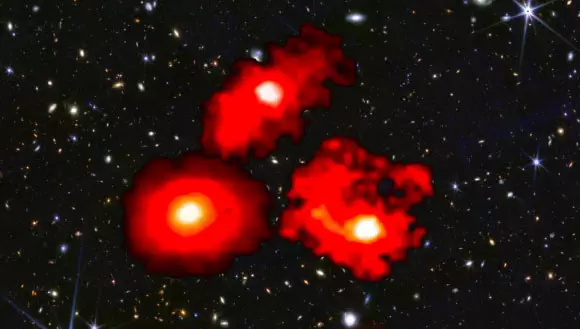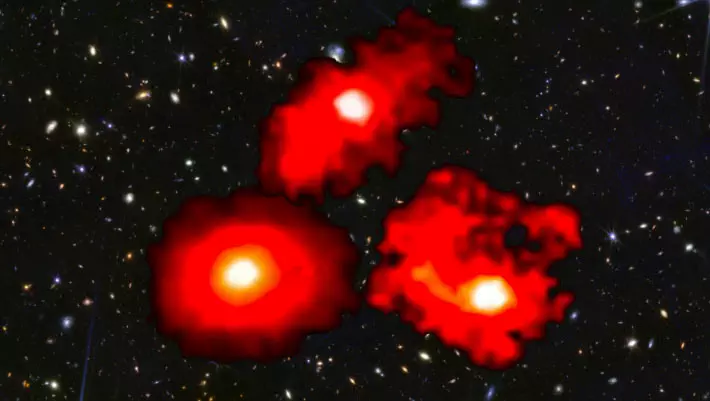Top Stories Tamfitronics
Astronomers using the NASA/ESA/CSA James Webb Space Telescope have discovered three ultra-massive galaxies — nearly as massive as our own Milky Way Galaxy — already in place within the first billion years after the Big Bang. Part of the JWST/FRESCO survey, this discovery indicates that stars in the early Universe grew much more rapidly than previously thought, challenging existing galaxy formation models.

The three red monster galaxies discovered by Webb. Image credit: NASA / CSA / ESA / M. Xiao & P. A. Oesch, University of Geneva / G. Brammer, Niels Bohr Institute / Dawn JWST Archive.
Until now, it was believed that all galaxies formed gradually within large halos of dark matter.
Dark matter halos capture gas (atoms and molecules) into gravitationally bound structures.
Typically, 20% of this gas, at most, is converted into stars in galaxies.
However, the new findings challenge this view, revealing that massive galaxies in the early Universe may have grown far more rapidly and efficiently than previously thought.
“The question of ‘impossibly’ massive galaxies shortly after the Big Bang has vexed astronomers ever since the first Webb images,” said Dr. Ivo Labbé, an astronomer at Swinburne University of Technology.
“This is akin to finding a toddler weighing 100 kg. Webb has now proven monsters do roam the early Universe.”
Most sources found in the FRESCO survey fit existing models, but the astronomers also found three surprisingly massive galaxies, with stellar masses comparable to today’s Milky Way.
They have been named ‘red monsters,’ due to their high dust content, which gives them a distinct red appearance in the Webb images.
These are forming stars nearly twice as efficiently as their lower-mass counterparts and galaxies at later times.
“These findings raise new questions for galaxy formation theories, specifically the issue of ‘too many, too massive’ galaxies in the early Universe,” Dr. Labbé said.
“Current models fail to explain how it is possible star formation is so super-efficient, very early in the Universe”.
“The usual assumption is that exploding stars and supermassive black holes kill star formation, blowing out the candle.”
“No doubt future Webb observations will provide us clues as to what we are missing.”
“Finding three such massive beasts among the sample poses a tantalizing puzzle,” said Professor Stijn Wuyts, an astronomer at the University of Bath.
“Many processes in galaxy evolution have a tendency to introduce a rate-limiting step in how efficiently gas can convert into stars, yet somehow these red monsters appear to have swiftly evaded most of these hurdles.”
“These results indicate that galaxies in the early Universe could form stars with unexpected efficiency,” said Dr. Mengyuan Xiao, an astronomer at the University of Geneva.
“As we study these galaxies in more depth, they will offer new insights into the conditions that shaped the Universe’s earliest epochs.”
“The red monsters are just the beginning of a new era in our exploration of the early Universe.”
“That is what is so great about astronomy, we’re constantly being surprised by new discoveries,” Professor Wuyts said.
“Already in its first few years of operation, Webb has thrown us a couple of curveballs.”
“In more ways than one, it has shown us that some galaxies mature rapidly during the first chapters of cosmic history.”
A paper on the findings appears in the journal Nature.
_____
M. Xiao et al. Accelerated formation of ultra-massive galaxies in the first billion years. Naturepublished online November 13, 2024; doi: 10.1038/s41586-024-08094-5



